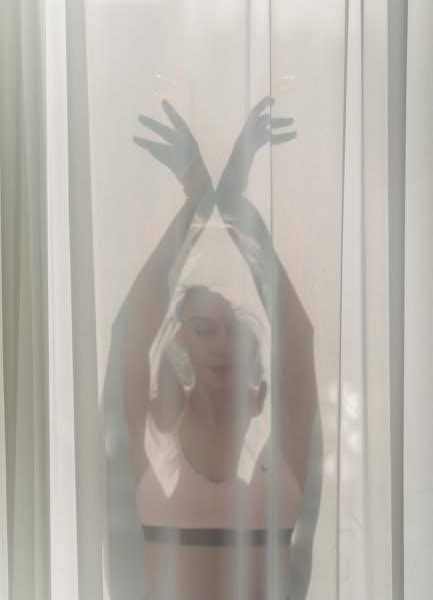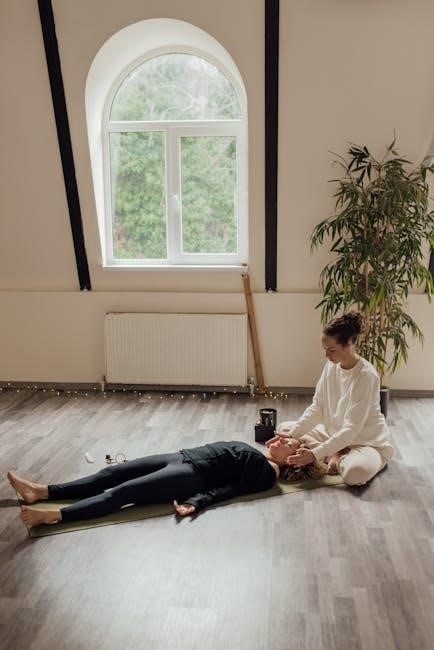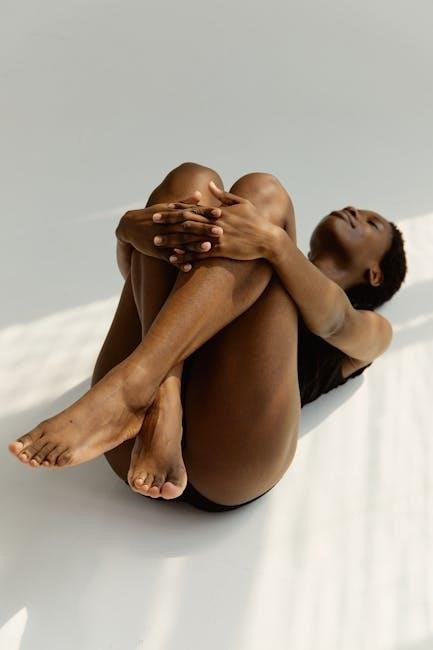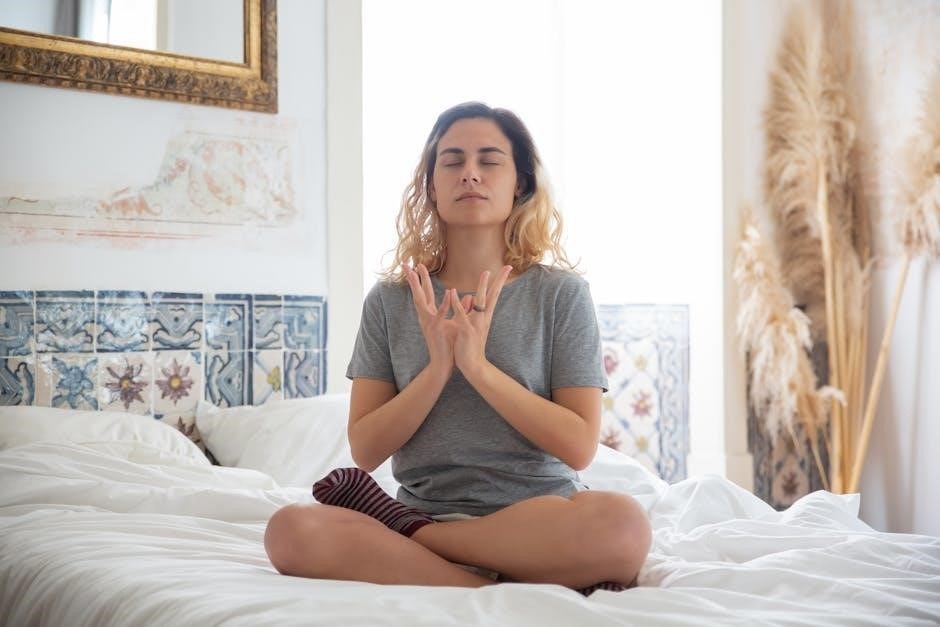
gentle yoga sequence pdf
Welcome to the Gentle Yoga Sequence PDF, a comprehensive guide designed for all levels. This resource offers a series of calming poses, breathing techniques, and relaxation methods to promote overall well-being. Perfect for beginners or those seeking a soothing practice, it includes step-by-step instructions and modifications to suit individual needs. Discover how gentle yoga can enhance flexibility, reduce stress, and foster inner peace with its thoughtfully curated sequences and restorative practices.
What is Gentle Yoga?
Gentle Yoga is a soft and accessible practice designed for all levels, emphasizing relaxation and mindfulness. It combines slow, deliberate movements with deep breathing to promote flexibility, balance, and inner calm. Suitable for beginners, seniors, or those recovering from injuries, Gentle Yoga focuses on holding poses for extended periods, often with the support of props like bolsters or blankets. This practice prioritizes comfort and awareness, allowing individuals to connect with their bodies in a nurturing way. By blending elements of restorative and therapeutic yoga, Gentle Yoga creates a peaceful environment for healing and self-care, making it an ideal choice for anyone seeking a calming and rejuvenating experience.
Why Choose Gentle Yoga?
Gentle Yoga is an excellent choice for those seeking a low-impact, therapeutic practice that promotes relaxation and reduces stress. It is ideal for individuals recovering from injuries, managing chronic pain, or simply looking to unwind. The slow-paced and meditative nature of Gentle Yoga makes it accessible to all, regardless of age or fitness level. By incorporating restorative poses and mindful breathing, it helps improve flexibility, balance, and overall well-being. This practice also fosters a deeper connection between body and mind, encouraging self-awareness and emotional healing. Whether you’re a beginner or seeking a calming complement to your existing routine, Gentle Yoga offers a transformative and nurturing experience.

Benefits of Gentle Yoga
Gentle Yoga enhances flexibility, strengthens muscles, and improves balance while reducing stress and anxiety. It promotes deep relaxation, improves circulation, and fosters mental clarity and emotional well-being.
Physical Benefits
Gentle Yoga offers numerous physical benefits, including improved flexibility, muscle strength, and enhanced circulation. It supports joint health by reducing stiffness and promoting mobility. Low-impact movements make it ideal for those with limited mobility or chronic pain, while deep breathing enhances oxygen flow. Regular practice can improve posture, balance, and overall physical alignment. Additionally, gentle stretches help release tension, reducing muscle strain and promoting relaxation. This practice is particularly beneficial for strengthening core muscles and improving bone density, making it suitable for all ages and fitness levels. By incorporating restorative poses, gentle yoga aids in recovery and rejuvenation, ensuring a holistic approach to physical well-being.
Mental and Emotional Benefits
Gentle Yoga nurtures mental and emotional well-being by fostering mindfulness and calm. It reduces stress and anxiety through deep breathing and relaxation techniques. The practice encourages emotional resilience, helping to manage mood swings and promote a sense of balance. By creating a safe space for self-reflection, gentle yoga enhances self-awareness and emotional stability. It also alleviates symptoms of depression by uplifting the spirit and improving overall mental clarity. The meditative aspects of gentle yoga cultivate inner peace, allowing practitioners to connect with their emotions on a deeper level. Regular practice fosters self-compassion and equips individuals with tools to navigate life’s challenges with greater ease and emotional strength.

Essential Gentle Yoga Poses
Explore foundational gentle yoga poses like Seated Forward Fold, Cat-Cow, Legs-Up-The-Wall, Sphinx, and Child’s Pose. These poses improve flexibility, enhance relaxation, and gently strengthen the body.
Seated Warm-Ups
Seated warm-ups are a gentle and effective way to prepare the body for yoga practice. Begin with simple movements like neck stretches, shoulder rolls, and wrist rotations to release tension. Incorporate breathing exercises, such as deep belly breaths, to center the mind. Transition into seated twists, gently turning the torso side to side, and cat-cow stretches to warm the spine. These poses improve flexibility, enhance circulation, and create a calm, focused state. Use a bolster or pillow for support if needed, ensuring comfort throughout the sequence. Spend 3-5 breaths in each pose to fully experience the benefits. This foundational practice sets the tone for a nurturing and transformative yoga session.
Restorative Poses
Restorative yoga focuses on deep relaxation and rejuvenation. Use bolsters, blankets, or pillows to support the body in calming postures. Legs-Up-The-Wall Pose is a popular choice, promoting circulation and reducing stress. Reclined Pigeon Pose gently stretches the hips, while Supported Child’s Pose fosters a sense of safety and calm. Spend 5-10 minutes in each pose, breathing deeply to allow the body to release tension. These poses encourage the nervous system to shift into a restorative state, enhancing emotional resilience and physical recovery. Restorative yoga is ideal for those seeking relaxation, making it a cornerstone of gentle yoga sequences. It’s a powerful way to nurture both body and mind, fostering deep relaxation and inner peace.
Supine Poses
Supine poses, performed while lying on your back, are excellent for relaxation and gentle stretching. Begin with Constructive Rest, bending knees and placing feet flat on the floor to support the lower back. This pose promotes spinal alignment and relaxation. Reclined Pigeon Pose gently stretches the hips, while Reclined Spinal Twist enhances flexibility and reduces tension. Use bolsters or pillows under the knees or torso for added comfort. These poses are ideal for improving posture, relieving lower back tension, and preparing the body for deep relaxation. Supine poses are calming and rejuvenating, making them a perfect addition to any gentle yoga sequence. They encourage mindful breathing and release, fostering a sense of calm and balance.

How to Create a Gentle Yoga Sequence
Start with gentle warm-ups, then transition to restorative poses, and conclude with final relaxation. This balanced flow ensures a transformative and rejuvenating experience for all practitioners.
Understanding Class Sequencing
Class sequencing in gentle yoga involves organizing poses to create a balanced and therapeutic experience. Begin with gentle warm-ups to prepare the body, followed by restorative poses for deep relaxation. Transition smoothly between poses, ensuring a logical flow that honors the body’s needs. Incorporate breathing techniques to enhance relaxation and focus. Use props like bolsters and blankets to support postures and make them accessible for all. End with final relaxation to seal the practice’s benefits. This structured approach ensures a harmonious and rejuvenating session, catering to both physical and emotional well-being. Proper sequencing fosters a safe, nurturing environment for practitioners of all levels.
Designing a Transformative Class
Designing a transformative gentle yoga class begins with intention and purpose. Start by setting a clear objective, such as stress relief or improved flexibility. Select poses that align with this goal, ensuring a logical progression from warm-ups to deeper stretches. Incorporate breathing exercises to enhance mindfulness and relaxation. Use restorative poses to create moments of deep calm, supported by props like bolsters and blankets. Pay attention to transitions, allowing ample time for students to move comfortably. End with a profound relaxation technique to seal the practice’s benefits. This thoughtful design fosters a safe, nurturing space where students can experience physical, mental, and emotional transformation. A well-crafted sequence ensures a meaningful and lasting impact.
Importance of Props in Gentle Yoga
Props like bolsters, blankets, and blocks provide essential support and comfort in gentle yoga. They enhance accessibility, allowing deeper relaxation and proper alignment for all practitioners.
Using Bolsters and Blankets
Bolsters and blankets are indispensable in gentle yoga, offering support and comfort. Bolsters can be placed under the knees, lower back, or neck to promote relaxation and proper alignment. Blankets provide cushioning for joints and help maintain body warmth during restorative poses. They allow practitioners to sink deeper into postures without strain, enhancing the therapeutic benefits. By using these props, individuals can customize their practice to suit their needs, ensuring a safe and rejuvenating experience. This makes gentle yoga accessible to everyone, regardless of flexibility or physical limitations, fostering a sense of calm and well-being.

Safety Precautions and Modifications
Ensure a safe practice by honoring your body’s limits. Avoid poses that cause discomfort or pain, especially if recovering from injuries. Use props for support and modify postures to suit your needs, fostering a gentle and therapeutic experience. Prioritize proper alignment and listen to your body to prevent strain. This mindful approach allows for a nurturing and effective yoga session tailored to individual requirements.
Poses to Avoid for Certain Conditions
Certain yoga poses should be avoided depending on specific health conditions. For individuals with osteoporosis, deep forward bends or twists that compress the spine are not recommended. Those with neck injuries should avoid poses that involve heavy weight-bearing on the cervical spine; Pregnant women should steer clear of deep twists, backbends, and any pose that puts pressure on the abdomen. Additionally, inverted poses like headstands or shoulder stands are contraindicated for people with high blood pressure or glaucoma. It’s essential to consult with a healthcare professional or a qualified yoga instructor to determine safe modifications for your practice. This ensures a gentle and injury-free experience.
Final Relaxation Techniques
Final relaxation is a crucial part of any gentle yoga practice, allowing the body and mind to fully unwind. Lie on your back with knees slightly bent, feet flat on the floor, and arms by your sides. Close your eyes and take deep, rhythmic breaths. Use a bolster or blanket under the knees or lower back for added comfort. Visualize each body part relaxing, starting from the toes and moving up to the head. Stay in this pose for 5-10 minutes to rejuvenate your energy. This technique promotes deep calm, reduces stress, and leaves you feeling refreshed and centered. It’s the perfect way to conclude your gentle yoga sequence.
Leave a Reply
You must be logged in to post a comment.